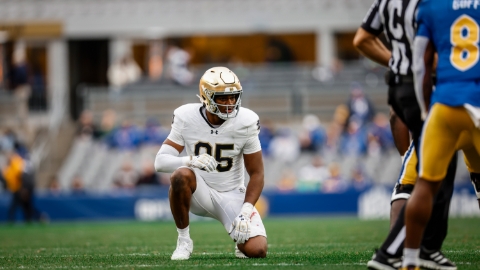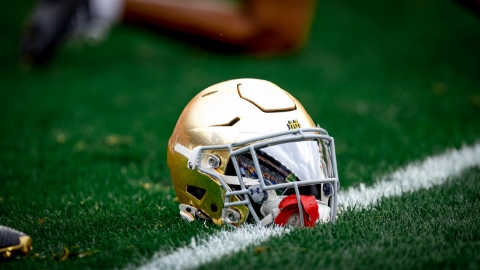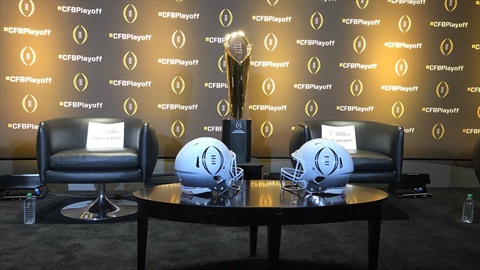
There’s a lot of metrics used to evaluate offenses in college football, but when it comes down to it, nothing matters more than points on the board.
On their way to an 11-win season in 2019, the Irish finished 13th in points per game. It’s the only time they have finished in the top-15 in that statistic during Brian Kelly’s tenure.
It’s not a coincidence that the top-four programs in scoring offense last season were LSU, Alabama, Ohio State, and Clemson. It’s also not a coincidence that each of those teams finished in the top-10 in plays from scrimmage of 30 yards or more.
That’s the company Notre Dame wants to be in under Tommy Rees. They want to be putting up over 40 points per game and be able to compete if they get into a shootout with those elite programs. The best way to do that is to be a more explosive offense. Whether that is explosive running or explosive throwing, it does not matter. It only matters that they are able to consistently produce plays of 30 yards or longer.
Notre Dame finished tied for 34th in that category in 2019.
Why 30 or more? The simple answer is that it’s the kind of play that it can typically give an offense a scoring opportunity if the offense is not pinned deep. A more appropriate answer would be that it makes an offense have to be less perfect with execution when they can gain big chunk yards rather than methodically moving the chains.
Last season when the Irish had a drive that included a play of 30 yards or more, they scored points 93.8% of the time. 84.3% of those drives resulted in touchdowns. The average points per drive was 6.19.
That’s not just a one year anomaly for them. Over the last three seasons, they averaged 6.03 points per drive on 99 offensive series. They scored on 93% of drives and scored touchdowns on 81.8% of them. There were only seven drives when a drive that included a play of 30 yards or more didn’t result in points. They were almost all scoring opportunities, it was just that Notre Dame failed to cash in on them (like missing a field goal against Virginia or throwing a red zone interception against Virginia Tech).
Only once they did have a play of 30 yards or more and end up punting.
So, big chunk plays are pretty important when it comes to scoring points and scoring points means winning games. They matter a lot in the big games too.
The Irish only had one play of 30 yards or more against Georgia in 2017 (scored 19 points in a loss). They had zero against Michigan last fall (14 points in a loss). They were almost upset by an inferior Virginia Tech team at home and had only one play of 30 or more in a one point victory (21 points).
They had zero against Clemson in 2018 (3 points). They had zero against Miami in 2017 (8 points). They had two against Georgia in 2019 (17 points). No one is beating any opponent scoring single digits in points in a game. It’s incredibly difficult to win scoring less than 20 in college football. A few big plays sprinkled into the two Georgia games could have changed the outcome.
It’s obvious if Notre Dame wants to get into the same category as those elite teams, they’ll need to create more explosive plays. When Chip Long was offensive coordinator, he did a good job using scheme to produce them. That’s something that Rees can build on and it’s something I wrote about back in February in terms of being inspired by the offense the San Francisco 49ers run.
It has to be more than scheme, though. What Long didn’t do well is utilize all of his playmakers. Chase Claypool was the deserved WR1 for the Irish, but Long failed to find other ways to get others involved in big plays, aside from Braden Lenzy, as the season progressed.
Lenzy will have to have his role expanded this season (five plays of 30 yards or more on only 24 touches). That will help, but Notre Dame will also need others to emerge.
Only one running back with a carry of over 30 yards in 2019 remains on the roster (Jahmir Smith) and Jafar Armstrong has only two plays of 30 yards or more in 142 career touches from scrimmage. Kevin Austin has the potential to be a big play guy (one of his five catches as a freshman went for 38 yards). We’ll see if he can be consistent with it.
There are four other players who stand out as other potential playmakers:
Lawrence Keys has shown flashes in practice of dynamic ability from the slot, although we didn’t see that on Saturdays last season.
Kendall Abdur-Rahman had seven touchdowns of 60 yards or longer as a high school quarterback.
True freshman running back Chris Tyree might be the fastest player on the team next season and scored touchdowns of 92 and 80 yards in high school.
True freshman wide receiver Jordan Johnson averaged over 20 yards per reception in high school and shows an outstanding ability to win contested catches deep down the field.
They might not need any of those guys to be consistent producers of the big play, but even if each of them contribute a handful to the season, it would go a long way into helping the offense make the leap into the top tier in the country.
It’s about more than just scoring 40 points a game overall. It’s about being able to have big plays in the big games to not have the offense play as perfect against talented defenses. If Notre Dame wants to win games against Wisconsin and Clemson this season, they’re going to have to score more than 20 points to do it. If they’re going score more than 20 points, they’ll need to have as many series as possible with plays of 30 yards or more.



